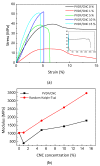Electroactive γ-Phase, Enhanced Thermal and Mechanical Properties and High Ionic Conductivity Response of Poly (Vinylidene Fluoride)/Cellulose Nanocrystal Hybrid Nanocomposites
- PMID: 32041217
- PMCID: PMC7040804
- DOI: 10.3390/ma13030743
Electroactive γ-Phase, Enhanced Thermal and Mechanical Properties and High Ionic Conductivity Response of Poly (Vinylidene Fluoride)/Cellulose Nanocrystal Hybrid Nanocomposites
Abstract
Cellulose nanocrystals (CNCs) were incorporated into poly (vinylidene fluoride) (PVDF) to tailor the mechanical and dielectric properties of this electroactive polymer. PVDF/CNC nanocomposites with concentrations up to 15 wt.% were prepared by solvent-casting followed by quick vacuum drying in order to ensure the formation of the electroactive γ-phase. The changes induced by the presence of CNCs on the morphology of PVDF and its crystalline structure, thermal properties, mechanical performance and dielectric behavior are explored. The results suggest a relevant role of the CNC surface -OH groups, which interact with PVDF fluorine atoms. The real dielectric constant ε' of nanocomposites at 200 Hz was found to increase by 3.6 times up to 47 for the 15 wt.% CNC nanocomposite due to an enhanced ionic conductivity provided by CNCs. The approach reported here in order to boost the formation of the γ-phase of PVDF upon the incorporation of CNCs serves to further develop cellulose-based multifunctional materials.
Keywords: PVDF; cellulose nanocrystals; electrical properties; mechanical properties; nanocomposites.
Conflict of interest statement
The authors declare no conflict of interest.
Figures






Similar articles
-
Gold-Nanoparticle-Deposited TiO2 Nanorod/Poly(Vinylidene Fluoride) Composites with Enhanced Dielectric Performance.Polymers (Basel). 2021 Jun 23;13(13):2064. doi: 10.3390/polym13132064. Polymers (Basel). 2021. PMID: 34201841 Free PMC article.
-
Effect of Cellulose Nanofibrils and TEMPO-mediated Oxidized Cellulose Nanofibrils on the Physical and Mechanical Properties of Poly(vinylidene fluoride)/Cellulose Nanofibril Composites.Polymers (Basel). 2019 Jun 27;11(7):1091. doi: 10.3390/polym11071091. Polymers (Basel). 2019. PMID: 31252644 Free PMC article.
-
Enhancement of electroactive β phase crystallization and dielectric constant of PVDF by incorporating GeO2 and SiO2 nanoparticles.Phys Chem Chem Phys. 2015 Sep 21;17(35):22784-98. doi: 10.1039/c5cp03975d. Epub 2015 Aug 11. Phys Chem Chem Phys. 2015. PMID: 26260070
-
Cellulose nanocrystals in the development of biodegradable materials: A review on CNC resources, modification, and their hybridization.Int J Biol Macromol. 2024 Feb;258(Pt 1):128834. doi: 10.1016/j.ijbiomac.2023.128834. Epub 2023 Dec 19. Int J Biol Macromol. 2024. PMID: 38128804 Review.
-
The Preparation, Structural Design, and Application of Electroactive Poly(vinylidene fluoride)-Based Materials for Wearable Sensors and Human Energy Harvesters.Polymers (Basel). 2023 Jun 21;15(13):2766. doi: 10.3390/polym15132766. Polymers (Basel). 2023. PMID: 37447413 Free PMC article. Review.
Cited by
-
Microfluidic Processing of Piezoelectric and Magnetic Responsive Electroactive Microspheres.ACS Appl Polym Mater. 2022 Jul 29;4(8):5368-5379. doi: 10.1021/acsapm.2c00380. eCollection 2022 Aug 12. ACS Appl Polym Mater. 2022. PMID: 36824683 Free PMC article.
-
Hybrid Nanofillers Creating the Stable PVDF Nanocomposite Films and Their Effect on the Friction and Mechanical Properties.Polymers (Basel). 2022 Sep 14;14(18):3831. doi: 10.3390/polym14183831. Polymers (Basel). 2022. PMID: 36145976 Free PMC article.
-
Enhanced electrical and thermal properties of semi-conductive PANI-CNCs with surface modified CNCs.RSC Adv. 2021 Mar 19;11(19):11444-11456. doi: 10.1039/d0ra10663a. eCollection 2021 Mar 16. RSC Adv. 2021. PMID: 35423653 Free PMC article.
References
-
- Martins P., Lopes A.C., Lanceros-Mendez S. Electroactive phases of poly(vinylidene fluoride): Determination, processing and applications. Prog. Polym. Sci. 2014;39:683–706. doi: 10.1016/j.progpolymsci.2013.07.006. - DOI
-
- Prud’homme R.E. Crystallization and morphology of ultrathin films of homopolymers and polymer blends. Prog. Polym. Sci. 2016;54–55:214–231. doi: 10.1016/j.progpolymsci.2015.11.001. - DOI
-
- Cui Z., Hassankiadeh N.T., Zhuang Y., Drioli E., Lee Y.M. Crystalline polymorphism in poly(vinylidenefluoride) membranes. Prog. Polym. Sci. 2015;51:94–126. doi: 10.1016/j.progpolymsci.2015.07.007. - DOI
-
- Kawai H. The piezoelectricity of poly (vinylidene fluoride) Jpn. J. Appl. Phys. 1969;8:975–976. doi: 10.1143/JJAP.8.975. - DOI
Grants and funding
LinkOut - more resources
Full Text Sources

